Last Updated on February 23, 2025 by Kittredge Cherry

LGBTQ Pride celebrations are rooted in sacred resistance — when queer people fought back against harassment at New York City’s Stonewall Inn, they launched the modern LGBTQ liberation movement on June 28, 1969. Their bold rebellion against government persecution of homosexuality is commemorated around the world during June as LGBTQ Pride Month.
The LGBTQ people who resisted police at the Stonewall Rebellion (also known as the Stonewall Riots) are not saints in the traditional sense. But they are honored here as “saints of Stonewall” because they dared to battle an unjust system. Some were active in church, but they do not necessarily represent religious faith — they stand for the human spirit and faith in ourselves as LGBTQ people. They performed the miracle of transforming shame into pride.
These “saints” began a process in which self-hating individuals were galvanized into a cohesive community. Their saintly courage inspired a justice movement that is still growing stronger after 50 years. The Stonewall Uprising continues to inspire a variety of art that is featured here.
In honor of Stonewall, progressive churches often celebrate the last Sunday in June as Pride Sunday. It is honored as the Feast of the Rainbow Christ by Seattle’s Inclusive Catholic communities of Living Water and Holy Questions.
Stonewall Rebellion remembered
Before Stonewall, homosexuality was illegal and police regularly raided gay bars, where customers submitted willingly to arrest. A couple of dozen acts of resistance pre-dated and paved the way for Stonewall, such as the 1967 demonstration at the Black Cat Tavern in Los Angeles. Almost a century earlier, William Dorsey Swann became the first American to lead a queer resistance group and the first to self-identify as a “queen of drag.” He fought back against police who raided a drag ball in 1888 in Washington DC.
The Stonewall Inn catered to the poorest and most marginalized queer people: drag queens, transgender folk, hustlers and homeless youth. It was (and still is) located on Christopher Street in the heart of New York City’s LGBTQ community. There is no consensus about who started it, but this time they defied the police raid in the early morning hours of June 28, 1969. Soon the crowd was pelting the officers with coins, bottles, bricks and the like. The police, caught by surprise, used nightsticks to beat some people before taking refuge in the bar itself. News of the uprising spread quickly. Hundreds gathered on the street and a riot-control police unit arrived. Violence continued as some chanted, “Gay power!”
Drag queens started spontaneous Rockettes-style kicklines facing the police with clubs and helmets. They met violence with defiant humor by singing,
We are the Stonewall girls
We wear our hair in curls
We wear no underwear
We show our pubic hair
We wear our dungarees
Above our nelly knees!
That dramatic moment is captured in the painting “It was Beautiful” by Douglas Blanchard. This and other Stonewall paintings by Blanchard were shown at the Lesbian and Gay Community Services Center of New York in 1999. “This painting was part of a series I made about the activists Marty Robinson and Tom Doerr in the 1990s,” Blanchard said. “The official title of this painting is ‘It Was Beautiful’ from Robinson’s firsthand account of the riots.”
On the first night of the Stonewall uprising, 13 people were arrested and some hospitalized. The streets were mostly cleared by 4 a.m., but a major confrontation with police happened again the next night, and protests continued on a smaller scale for a week.
A month later the Gay Liberation Front was formed, one of many LGBTQ rights organizations sparked by the saints of Stonewall. The first Pride marches were organized a year later in Chicago, New York City, San Francisco and Los Angeles to commemorate the first anniversary of the Stonewall rebellion.
Stonewall marked a major new beginning in a much longer struggle toward rights for sexual and gender minorities. It follows previous efforts, including Harry Hay of the Mattachine Society, Del Martin and Phyllis Lyon of the Daughters of Bilitis, the Annual Reminder protests in the 1960s, and Henry Gerber and John T. Graves of the Society for Human Rights in the 1920s.
Tributes commemorate Stonewall
The site of the Stonewall Uprising was designated a national monument by President Obama in 2016. “I’m designating the Stonewall National Monument as the newest addition to America’s National Park System. Stonewall will be our first national monument to tell the story of the struggle for LGBT rights,” he said.
The White House also released a video about the Stonewall Uprising and how it sparked a movement for LGBT equality. The monument includes the Stonewall Inn and nearly eight acres around it in New York’s Greenwich Village.
 A controversial effort to tell the story of the uprising is the 2015 film “Stonewall.” It is directed by Roland Emmerich, better known for directing the action movie “Independence Day.” The film is a drama, not a documentary, told through the eyes of a fictional young white man from Indiana. Many in the LGBT community objected that the film downplayed the importance of drag performers, trans and bi women, butch lesbians and people of color in the Stonewall rebellion. Boycotts were organized to protest the way the erasure of these real-life activists in favor of a fictional white man.
A controversial effort to tell the story of the uprising is the 2015 film “Stonewall.” It is directed by Roland Emmerich, better known for directing the action movie “Independence Day.” The film is a drama, not a documentary, told through the eyes of a fictional young white man from Indiana. Many in the LGBT community objected that the film downplayed the importance of drag performers, trans and bi women, butch lesbians and people of color in the Stonewall rebellion. Boycotts were organized to protest the way the erasure of these real-life activists in favor of a fictional white man.
Stonewall in art
One of the most significant Stonewall artworks is also the world’s first piece of public art honoring the struggle for LGBTQ equality. “Gay Liberation” was created in 1979 by famed pop sculptor George Segal. It consists of four statues, a gay couple and a lesbian couple, cast in bronze and painted white in Segal’s typical style. The figures are arranged realistically in casual poses, evoking the power of love with their ghostly presence.
The idea for a public sculpture honoring the 10th anniversary of Stonewall came from LGBT activist Bruce Voeller. His vision inspired the Mildred Andrews Fund of Cleveland to commission Segal to create the sculpture. After much controversy, vandalism and alternate locations, the sculpture was installed permanently across the street from the Stonewall Inn at Christopher Park, which also holds two monuments to Civil War heroes.
Artists usually choose between two approaches when addressing the Stonewall Uprising. Some focus on the action in the past while others highlight the present-day Stonewall Inn, which is still in operation as a bar for the LGBT community.
Artists who recreate the past include Doug Blanchard, a gay New York artist who teaches art at City University of New York and is active in the Episcopal Church. “It was Beautiful” and other Stonewall paintings by Blanchard were shown at the Lesbian and Gay Community Services Center of New York in 1999. His series “The Passion of Christ: A Gay Vision” has been featured here at the Jesus in Love Blog and in a 2014 book with text by Kittredge Cherry.
California artist Sandow Birk put Stonewall history into heroic context in a big way. The oil paintings in his Stonewall series measure up to 10 feet wide. The crown jewel of the series is “The Battle of Stonewall – 1969.” It updates the classic painting “The Battle of Mons-en-Pévèle – 1304” by 19th-century French artist Charles Philippe Lariviere. In both cases, the physically superior side attacked those who were considered weaker, but the underdogs won and gained their freedom. Birk replaces swords with police batons and turns national flags into “Gay Power” banners. The knight in shining armor is replaced by a drag queen in mascara and high heels. For more about Birk’s Stonewall series, see my previous post: Sandow Birk: Stonewall’s LGBT history painted.
The actual Stonewall riots weren’t as white as Birk’s paintings make it appear: “On the first night of the Stonewall riots, African Americans and Latinos likely were the largest percentage of the protestors, because we heavily frequented the bar,” scholar-activist Irene Monroe writes in Dis-membering Stonewall, her chapter in the book Love, Christopher Street. “For homeless black and Latino LGBTQ youth and young adults who slept in nearby Christopher Park, the Stonewall Inn was their stable domicile.”
The location where history happened is emphasized in the colorful painting of the Stonewall Inn by Trudie Barreras, a long-time member of Metropolitan Community Churches. Her art and writing on queer religious themes have appeared frequently here at the Jesus in Love Blog. She also does personalized pet portraits as “donation incentives” for Q Spirit.
British artist Tony O’Connell paid homage to the power of Stonewall by photographing his own personal pilgrimage to the historic bar in New York City in 2013. He prayed with incense at the Stonewall Inn as part of his series on LGBT pilgrimages, which he does as performances recorded in photos. He travels to places of importance in LGBT history, treating the trip as a pilgrimage to the shrine of a saint. For more about O’Connell’s pilgrimages and other art, see my previous post Tony O’Connell reclaims sainthood: Gay artist finds holiness in LGBT people and places.
Jesus meets the women of Jerusalem and the Stonewall Riots happen in Station 8 from “Stations of the Cross: The Struggle For LGBT Equality” by Mary Button
Tennessee artist Mary Button weaves together the LGBT uprising at Stonewall with Christ’s journey to Calvary in Station 8 of her LGBT Stations of the Cross. She shows that a chain of oppression that stretches from the crucifixion of Christ to police harassment of LGBT people today, offering hope for resurrection. For more about Button’s Stations, see my previous post LGBT Stations of the Cross shows struggle for equality.
Stonewall prayers: “Change borne on a sea of tears”
Q Spirit’s Litany of Queer Saints includes this line:
Saints of Stonewall who performed the miracle of transforming self-hatred into pride, pray for us. May the saints of Stonewall continue to inspire all who seek justice and equality!
Stonewall is named in a powerful Pride Month hymn commissioned for the 2019 LGBTQ Pride celebration at Trinity Episcopal Church in Everett, Washington. Composed by Henry Lebedinsky, it includes these stanzas:
As we journey on together,
We remember those we’ve lost,
Those who could not make the voyage,
Those whose lives have paid the cost.
Stonewall, Laramie, Orlando…
Change borne on a sea of tears,
Bitter struggle, bitter hatred,
So much pain from so much fear.…
Through the years of loss and conflict,
We’ve been called to turn our hearts,
And together, be Love’s beacon
When all other light departs.
May we be the light God made us,
Rays of hope in times of pain;
Peace and justice be our promise,
Sunlight shining through the rain.
Who started Stonewall?
A whole community rose up together as one to fight oppression at the Stonewall Rebellion, but there is a lot of interest in exactly who started it. Their faces and stories bring history to life by illustrating who was there when it happened.
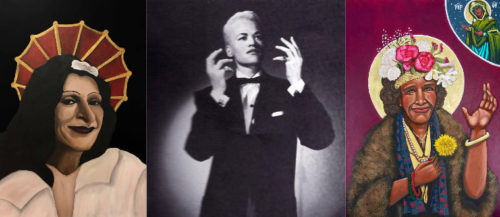
The historical truth is complex and witnesses disagree about which individual triggered the uprising, but the most commonly named possibilities are all queer people of color: biracial lesbian Stormé DeLarverie and two self-professed “drag queens”: African American Marsha P. Johnson and Latina Sylvia Rivera. All three have denied throwing the first punch or brick at the rebellion.
David Carter, author of the definitive book “Stonewall,” concludes that none of these three actually started the uprising in his well-researched 2019 article “Exploding the Myths of Stonewall” in the Gay City News.
And yet each of them has been called the Rosa Parks of the LGBTQ community. They have come to symbolize the moment when the LGBTQ community stopped accepting abuse and claimed the right to exist. Their images are joined here to form a queer trinity of Stonewall saints.
Johnson and Rivera were close friends who were both actively Christian. They sometimes appear together in images by various contemporary artists. In 1970 they co-founded the Street Transvestite Action Revolutionaries (STAR), an activist and social service organization for homeless queer youth. Both of them were also founding members of the Gay Liberation Front, which sprang up quickly in 1969 as a result of the Stonewall Rebellion.
In 2019 New York City announced plans to commission a statue of Johnson and Rivera, describing it as the “first permanent, public artwork recognizing transgender women in the world.” The monument is scheduled to be finished in 2021 and located in a park one block from the Stonewall Inn. A campaign called “Stormé DeLarverie deserves a New York City monument too!” is underway.
Saints of Stonewall: Stormé DeLarverie
Stormé DeLarverie (Dec. 24, 1920 – May 24, 2014) and many eyewitnesses say that her scuffle with police incited the crowd to action at the Stonewall Uprising. She was born to an African American mother and a white father in New Orleans.
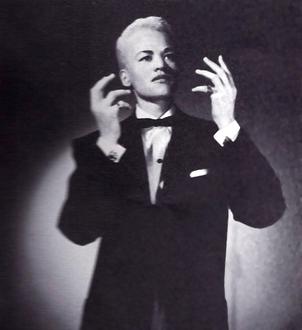
A spotlight forms a kind of halo behind Stormé DeLarverie in a 1950s promotional photo for her shows with the Jewel Box Revue (Wikipedia)
While growing up, DeLarverie was bullied and beaten for being biracial. Her jobs include performing as a “drag king” entertainer and working as a bouncer for mobsters and lesbian bars. For 15 years before the Stonewall Rebellion, DeLarverie was the only male impersonator in the Jewel Box Revue, the first racially integrated drag show in North America. She toured the black theater circuit and played such legendary venues as the Apollo Theater, Copacabana nightclub and Radio City Music Hall. DeLarverie was also photographed by Diane Arbus, renowned photographer of marginalized people. She died in her sleep at age 93.
Saints of Stonewall: Sylvia Ray Rivera
“Sylvia Rivera” icon by Jen Casselberry. Prints are available at her Etsy shop
Sylvia Ray Rivera (July 2, 1951 – Feb. 19, 2002) was born in New York City to a Venezuelan mother and Puerto Rican father. She was abandoned by her father and orphaned at age 3 when her mother committed suicide. When she was 11, Rivera was forced onto the streets by a grandmother who disapproved of her gender nonconformity and began working as a prostitute.
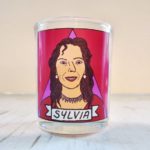
Sylvia Rivera candle by Robin Markle
Rumors say that Rivera threw the first bottle at police, inciting the Stonewall Rebellion. She was an active member of Metropolitan Community Church of New York, where she ministered through the food pantry. Her activism extended to poverty and racial justice as well as LGBTQ equality. She is the first transgender American to appear at the National Portrait Gallery in Washington DC. They displayed a photo of her at a Pride March by Luis Carle. She died of liver cancer at age 50.
Rivera smiles with a sidelong gaze and stylized halo in a modern icon by Chicago artist Jen Casselberry. She created it for a commissioned series of seven activist/contemplative icon paintings.
Saints of Stonewall: Marsha P. Johnson
Marsha P. Johnson (Aug. 24, 1945 – July 6, 1992) was born into an African American family in New Jersey. While growing up, Johnson was bullied by neighbors and harassed by family for gender-inappropriate dress and behavior. Raised in the African Methodist Episcopal Church, she was a devout lifelong Christian who was drawn to Catholicism and other faiths. She worked as a drag performer and was arrested more than 100 times for prostitution. Famous pop artist Andy Warhol personally photographed her for his “Ladies and Gentlemen” series of screenprints.

Marsha P. Johnson icon by Kelly Latimore
When asked what her middle initial “P” stood for, Johnson famously answered, “Pay it no mind” — the same jaunty reply that she used when people asked intrusive questions about her gender or sexuality. The police raided the Stonewall Inn when Johnson was reportedly celebrating her 25th birthday. Conflicting accounts say that Johnson started the rebellion by throwing a brick or shot glass. During her lifetime, she was called the Saint of Christopher Street for her activism and advocacy for queer homeless youth and AIDS patients. She died at age 46 and her body was found floating in the Hudson River. Her death at age 46 was initially ruled a suicide, but later New York City police reclassified her case as a drowning and possible murder.
Marsha P. Johnson has particularly caught the attention of icon painters. A new portrait of her was painted in classic icon style by Kelly Latimore of St. Louis, Missouri in 2019. It shows her with a halo behind her gorgeous flowered hat while Mary blesses her from the upper right corner.
Latimore is known for painting innovative icons of unlikely contemporary saints, such as a migrant family in his best-known work “Refugees: La Sagrada Familia.” It appears on the cover of “A Stranger and You Welcomed Me” by Pope Francis. He began painting icons in 2011 while he was a member of the Common Friars, an Episcopal monastic community in Athens, Ohio.
Rainbow Lounge Raid also happened on June 28
Despite the progress made, police raids of gay bars have continued in recent years, such as the notorious 2009 Rainbow Lounge raid in Forth Worth, Texas. June 28 is also the anniversary of the 2009 raid on the Rainbow Lounge, a gay bar in Fort Worth, Texas. Five customers were zip-tied and taken to jail, multiple others were arrested or detained, and one got a severe brain injury while in custody. The raid sparked an unprecedented public outcry that led to reforms.
The history of the Rainbow Lounge raid and reaction is told in the 2012 film “Raid of the Rainbow Lounge,” directed by Robert Camina. He says it has “haunting parallels” to Stonewall. Emmy-nominated actress Meredith Baxter narrates the documentary. A video trailer is posted online.
Links related to Stonewall
Book: “Stonewall: The Definitive Story of the LGBTQ Rights Uprising that Changed America” by Martin Duberman, classic re-released in 2019
Book: “The Stonewall Reader,” edited by New York Public Library, 2019
Book: “Stonewall: The Riots That Sparked the Gay Revolution” by David Carter
Video: “American Experience: Stonewall Uprising”
2015 book for teens: “Stonewall: Breaking Out in the Fight for Gay Rights” by Ann Bausum
___
To read this article in Russian, go to:
Святые Стоунволла (nuntiare.org)
___
Top image credit:
“It was Beautiful” by Douglas Blanchard shows the Stonewall Rebellion
___
This post is part of the LGBTQ Saints series by Kittredge Cherry. Traditional and alternative saints, people in the Bible, LGBTQ martyrs, authors, theologians, religious leaders, artists, deities and other figures of special interest to lesbian, gay, bisexual and transgender and queer (LGBTQ) people and our allies are covered.
This article was originally published on Q Spirit in June 2016, was expanded with new material over time, and was most recently updated on Feb. 23, 2025.
Copyright © Kittredge Cherry. All rights reserved.
Qspirit.net presents the Jesus in Love Blog on LGBTQ spirituality.
“Sylvia Rivera” icon by Jen Casselberry. Prints are available at her Etsy shop

Sylvia Rivera candle by Robin Markle of the Flaming Idols Etsy shop




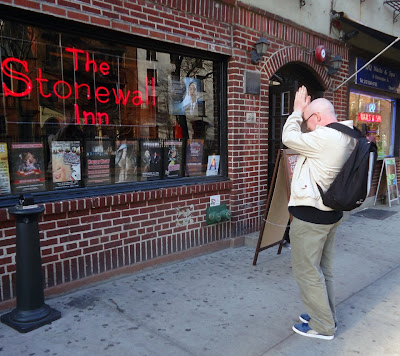
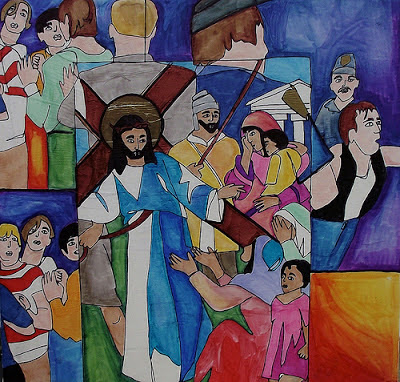
















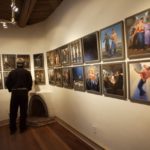



Trackbacks/Pingbacks